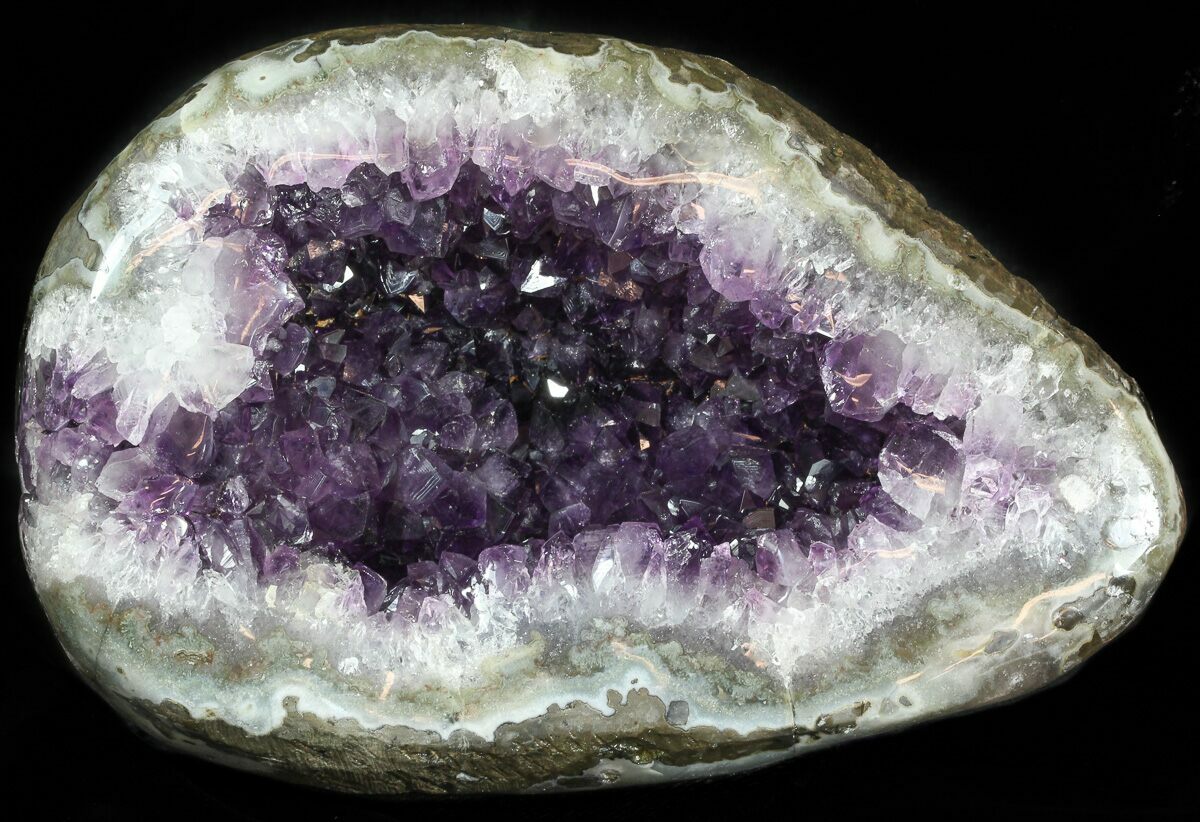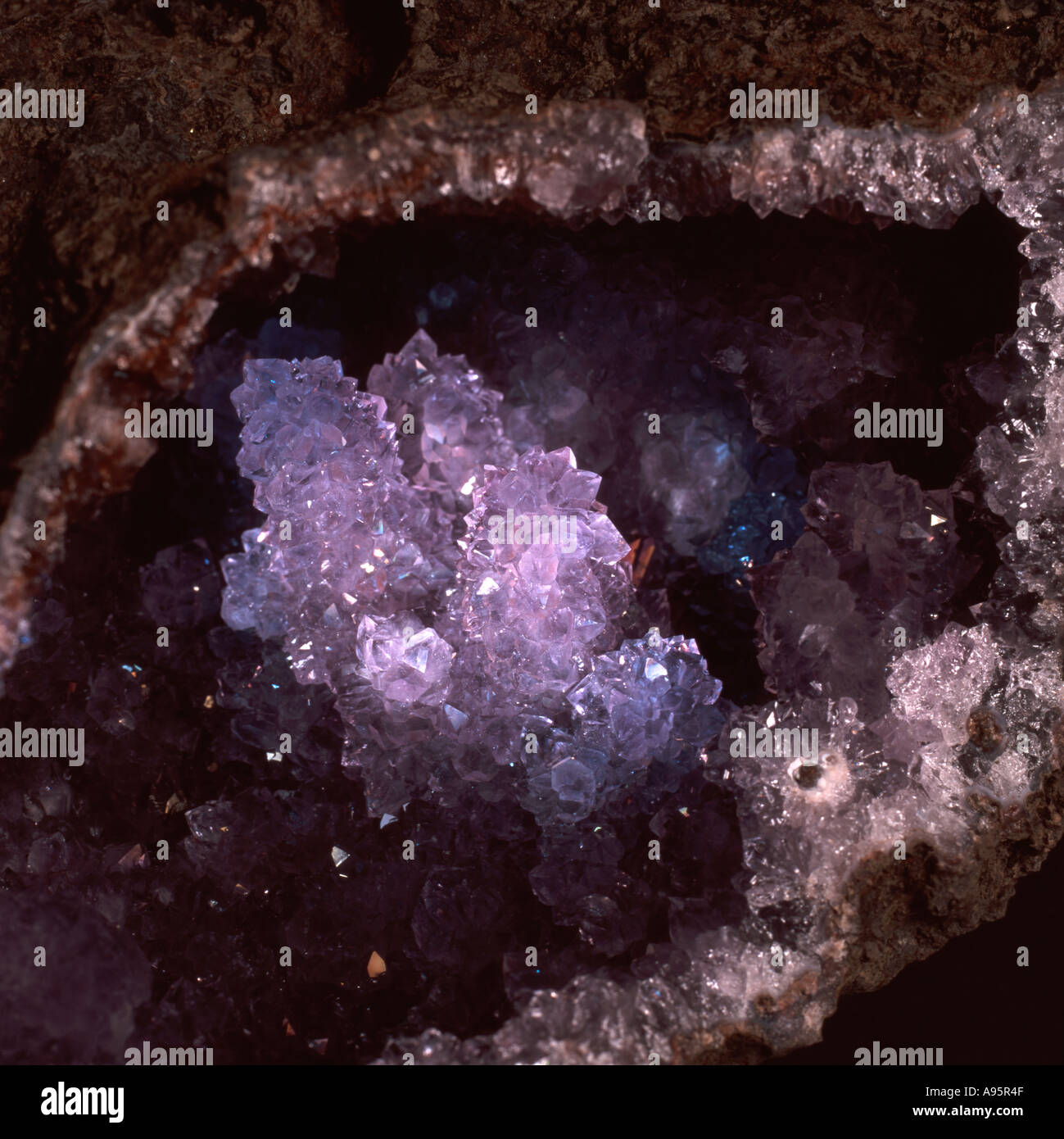

In Rio Grande do Sul, Brazil, the minerals trapped in the cavities form layers within the cavities, which typically include celadonite first, then agate, then quartz, and finally amethyst.

The mineral inclusions that are trapped within the geode cavity determines what type of crystals will be inside. Then, cooling and pressure release over many thousands and sometimes millions of years grows the crystals inside the cavity. The water that entered the cavities was salt water that contained inclusions of silica and other minerals from the ground below. Since it was basalt lava and basalt is porous, the water was able to penetrate the hollow cavities. When referring specifically to the lava flows in Brazil, it is thought that water from an aquifer below the lava was at some point forced out and up into the cavities in the lava. Typically, they are longer than they are wide, which is where the cathedral name came from - when they are cut in half, each half resembles a church cathedral. The size of these bubbles can range from microscopic to fifteen feet long. Those trapped bubbles form hollow cavities as the lava hardens around it. When the lava cools quickly, the lava thickens, and the bubbles can't reach the top. Gas bubbles within the lava rise to the top, just like the bubbles you see when you pour a soda. The first step in the formation of an amethyst geode occurs from the flow of lava. The Natural Formation of Amethyst Geodes Step 1 - Gas Bubbles Form Cavities in Lava However, the beautiful crystal part of the geode forms naturally over many thousands or millions of years before it is even touched by people. Afterall, the healing benefits of amethyst are quite extensive.Īmethyst cathedrals are partially man-made. Perhaps, the ancient wisdom that is contained in the amethyst is the reason it holds such transformative, healing powers. And that occurred about 130 million years ago!Īs you can see, owning an amethyst cathedral means you own a piece of the earth that existed millions of years ago. According to Show Me Rockhounds, approximately 800,000 cubic kilometers of lava extruded in this area over an 11 million year time span. These amethyst geodes from Brazil are mined from lava flows in the Parana Continental Flood Basalt Province, which is one of the most massive basalt lava outpourings that have been discovered to date. While amethyst geodes are found in Mexico, Uruguay, and even the United States, most of the amethyst geodes and amethyst cathedrals that are the most attractive and contain the deepest purple color comes from Rio Grande do Sul, Brazil. If amethyst geodes and amethyst cathedrals have intrigued you, and you've found yourself wondering how they are formed, read on! Where Do Amethyst Cathedrals Comes From?Īn amethyst cathedral, otherwise known as an amethyst church, is a geode that is typically tall and thin and shaped like the arch of a cathedral.Īmethyst is a type of quartz that contains a few parts per million of iron, providing its incredible purple color. No one can escape their draw, yet most of us have no idea how they came to be. They are miraculous, and every one of them is ancient. Multiply that effect times a thousand, and you might be able to understand what it would feel like to discover an amethyst geode the length of your arm.Īmethyst cathedrals and geodes are beautiful. If you have, then you've witnessed how miraculous and fascinating it is to see the wonderous, sparkling beauty that reveals itself from inside such an unassuming, rather boring rock.

AMETHYST GEODE OUTSIDE CRACKED
Have you ever cracked open a small geode that you bought at a store? If amethyst cathedrals have intrigued you, and you've found yourself wondering how they are formed, read on! INSIDE: Amethyst cathedrals are beautiful, powerful, miraculous, and every one of them is ancient.


 0 kommentar(er)
0 kommentar(er)
